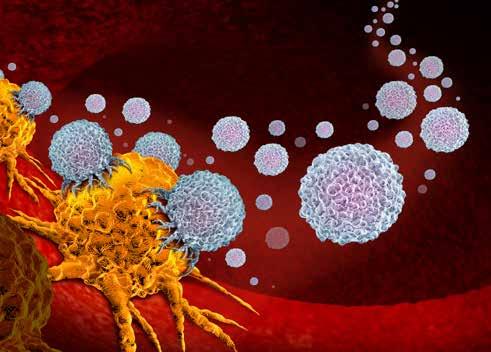
8 minute read
Acidic Environment Triggers Genes That Help Cancer Cells Metastasize
By Anne Trafton
Scientists have long known that tumors have many pockets of high acidity, usually found deep within the tumor where little oxygen is available. However, a new study from MIT researchers has found that tumor surfaces are also highly acidic, and that this acidity helps tumors to become more invasive and metastatic.
Advertisement
The study found that the acidic environment helps tumor cells to produce proteins that make them more aggressive. The researchers also showed that they could reverse this process in mice by making the tumor environment less acidic.
“Our findings reinforce the view that tumor acidification is an important driver of aggressive tumor phenotypes, and it indicates that methods that target this acidity could be of value therapeutically,” says Frank Gertler, a MIT professor of biology, a member of MIT’s Koch Institute for Integrative Cancer Research, and the senior author of the study. Former MIT postdoc Nazanin Rohani is the lead author of the study, which appears in the journal Cancer Research.
Mapping acidity
Scientists usually attribute a tumor’s high acidity to the lack of oxygen or hypoxia that often occurs in tumors because they don’t have an adequate blood supply. However, until now, it has been difficult to precisely map tumor acidity and determine whether it overlaps with hypoxic regions.
In this study, the MIT team used a probe called pH (Low) Insertion Peptide (pHLIP), originally developed by researchers at the University of Rhode Island, to map the acidic regions of breast tumors in mice. This peptide is floppy at normal pH but becomes more stable at low, acidic pH. When this
WWW.HWSMAG.COM happens, the peptide can insert itself into cell membranes. This allows the researchers to determine which cells have been exposed to acidic conditions by identifying cells that have been tagged with the peptide.
To their surprise, the researchers found that not only were cells in the oxygen-deprived interior of the tumor acidic, there were also acidic regions at the boundary of the tumor and the structural tissue that surrounds it, known as the stroma.
“There was a great deal of tumor tissue that did not have any hallmarks of hypoxia that was quite clearly exposed to acidosis,” Gertler says. “We started looking at that, and we realized hypoxia probably wouldn’t explain the majority of regions of the tumor that were acidic.”
Further investigation revealed that many of the cells at the tumor surface had shifted to a type of cell metabolism known as aerobic glycolysis. This process generates lactic acid as a by-product, which could account for the high acidity, Gertler says. The researchers also discovered that in these acidic regions, cells had turned on gene expression programs associated with invasion and metastasis. Nearly 3,000 genes showed pH-dependent changes in activity, and close to 300 displayed changes in how the genes are assembled, or spliced.
“Tumor acidosis gives rise to the expression of molecules involved in cell invasion and migration. This reprogramming, which is an intracellular response to a drop in extracellular pH, gives the cancer cells the ability to survive under low-pH conditions and proliferate,” Rohani says.
Those activated genes include Mena, which codes for a protein that normally plays a key role in embryonic development. Gertler’s lab had previously discovered that in some tumors, Mena is spliced differently, producing
an alternative form of the protein known as MenaINV (invasive). This protein helps cells to migrate into blood vessels and spread though the body.
Another key protein that undergoes alternative splicing in acidic conditions is CD44, which also helps tumor cells to become more aggressive and break through the extracellular tissues that normally surround them. This study marks the first time that acidity has been shown to trigger alternative splicing for these two genes.
Reducing acidity
The researchers then decided to study how these genes would respond to decreasing the acidity of the tumor microenvironment. To do that, they added sodium bicarbonate to the mice’s drinking water. This treatment reduced tumor acidity and shifted gene expression closer to the normal state. In other studies, sodium bicarbonate has also been shown to reduce metastasis in mouse models.
Sodium bicarbonate would not be a feasible cancer treatment because it is not welltolerated by humans, but other approaches that lower acidity could be worth exploring, Gertler says. The expression of new alternative splicing genes in response to the acidic microenvironment of the tumor helps cells survive, so this phenomenon could be exploited to reverse those programs and perturb tumor growth and potentially metastasis.
“Other methods that would more focally target acidification could be of great value,” he says. HWS
Anne Trafton is the life sciences writer at the MIT News Office. Article courtesy of MedicalXpress.com.
The Next Breakthrough in Cancer Therapy

Provided by the Nature Medicine Clinic
Did you know that Photodynamic therapy is thought to herald in one of the next breakthroughs in cancer therapy and antimicrobial research? A lot of research has been going in to finding a patentable photosensitive material that could be activated by a laser and selectively destroy cancerous tissues and infectious microorganisms.
The idea behind the treatment is the cancerous cells or infectious microorganisms absorb astronomically more of the photosensitizing material than normal tissue cells. Therefore, these cells or microorganisms become targeted. When the laser is administered, only the cells with a significant amount of the photosensitizer inside of them will be killed, having no effect on the normal cells aside from the positive benefits of being treated by the laser.
Each coloured laser activates a specific photosensitizer and research suggests the combination of these photosensitizers with their appropriate lasers is more effective than a solo photosensitizer with its corresponding solo laser. Turmeric and riboflavin are photoactivated by the blue laser. Hypericin (St. John’s wort) is activated with the yellow laser. The oral supplement photoactive plus is activated by red, yellow and blue laser respectively.
Photodynamic therapy is positioning itself to be the next breakthrough in cancer therapy and infectious disease. HWS

Photodynamic Therapy
Oncotherm
Hyperbaric Ten Pass Ozone
Nature Medicine Clinic is the only healthcare facility in North America that offers all three cutting edge technologies!
Just Over The Border

NatureMedicine.ca • (905) 684-4934 St. Catharines, Ontario CANADA
Alaina Hillier Doctor of Audiology, Audiologist, Reg. CASLPO
SEARCH FOR BETTER HEARING
NIAGARA FALLS LOCATION 4725 Dorchester Road, Unit B15 905.354.2757 FONTHILL LOCATION #20 Hwy 20, Unit 3, PO Box 162 289.897.8665 Schedule your free hearing health assessment today!
Visit our website to check your hearing online for free! hearagainclinics.com
The Importance of Minerals

The importance of minerals is often overlooked in our dietary and nutritional needs, as most tend to concentrate on vitamins. Minerals are the foundation of our nutrient source that allows vitamins to be readily absorbed in the body, as well as stimulate the proper function of hormones and enzymes for metabolic functions.
Minerals belong to the etheric body of need. This is the part of the energy that connects the physical body to the higher bodies within us. Minerals are sourced from land (soils), water (sea and lakes), and plants.
We used to obtain most of our minerals from the soil. But with soils being so deficient in nutrients, we’re forced to supplement as plants and animals are deficient in producing what we need to reach optimal nutrient proportions for healthy well-being.
There are two categories of minerals – macro-minerals and trace minerals. Macrominerals include calcium, magnesium, sodium, potassium, phosphorus, chloride, nitrogen and sulphur. Macro-minerals are needed in considerable amounts and stored in large quantities in the body. They’re also responsible for the function of organs and the synthesis of RNA.
By Catherine Bradley
Trace minerals include iron, iodine, selenium, copper, zinc, manganese, fluoride, molybdenum, and cobalt. Trace minerals are needed in small amounts and readily used in the body, generally not being stored. They are primarily responsible for DNA, cellular and glandular function.
The primary difference is in the amount we need to obtain optimal health. We require more macronutrients daily (well over 100 mg) while trace minerals are needed in tiny amounts (a few mg) per day to achieve optimal health.
Minerals work in conjunction with one another, and with the opposing function of different minerals, much like a polar opposite. The minerals encourage each other to function at their best. At the same time, each one competes for proper absorption in the organs, glands and cells. This allows the minerals to promote the function of one another. But it can also create a blockage if there’s too much of one mineral over another. Minerals can promote the function of vitamins or inhibit their ability to be absorbed, if imbalance is present. All minerals are an essential part of a balanced diet for true homeostasis to established. It is like gears of a clock. If one mineral is imbalanced, it throws off all the other mineral functions and vitamin absorptions. This can lead to malabsorption of vitamins, toxicity or deficiency that can impair DNA and RNA synthesis, and amino acid production. It can also create metabolic issues, as well as promote a plethora of physical and mental or emotional ailments such as digestion, arthritis, dental decay, osteoporosis, insomnia, anxiety, mood swings and depression, to name a few.
It is important to have a well-balanced diet of foods with essential nutrients. If there is concentration in a particular diet such as: vegan, vegetarian, paleo, or keto, there is an inclination to have an imbalance of minerals over a period of time. Should there be preference of a particular diet, it is recommended to supplement to obtain the nutrients you are lacking, although not ideal; optimal absorption is obtained through food intake over supplementation. HWS
Catherine Bradley is a Doctor of Medical Heilkunst for both humans and animals. To find out more about her practice, call Catherine at 905.684.8013, email cbradley@cogeco.ca or go to www.bradleyheilkunst.com.




